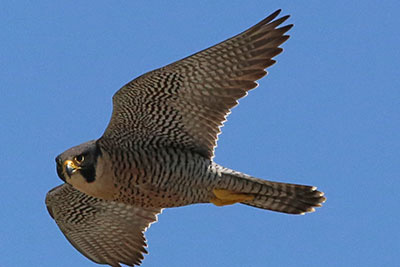Peregrine Falcons at UC Davis Medical Center
For the seventh season, a pair of peregrine falcons returned to their nest atop UC Davis Medical Center. The nest sits a safe distance from the hospital's busy helipad.
In March 2025, the peregrine falcons laid five eggs. Ultimately, four eggs hatched, welcoming three new female falcons and one male. The fifth egg was deemed unviable. The hatchlings have since grow and lost all white feathers. The next step is flight!
Find out more about what experts believe happened to last year's eggs
The chicks usually begin hatching in late April. William "Bill" Corbett, procurement supervisor at UC Davis Health, is also our resident falcon expert. He answered questions about these fascinating birds and why it's so unique to have them here.
About the Peregrine Falcon

The peregrine falcon used to be on the U.S. Endangered Species List. It was also one of the first birds placed on California's Endangered Species List.
Luckily, the raptor was removed from the federal list in 1999, thanks to efforts by The Peregrine Fund and others. The ban of DDT in 1972 in the U.S. also helped the species recover. The led to the falcons removal from the state Endangered Species List in 2009.
Experts estimate the first-year survival rate for the chicks is about 50%. Urban falcons face hazards such as injury, illness, and predators. The young birds typically fly away from the nest at the medical center sometime in mid-June. Experts say the birds usually stay in the area for another month as their parents continue to feed them and encourage them to hunt.
Here are a few other facts about peregrine falcons:
- Scientific name: Falco peregrinus
- Body length: 13-20 in (33-50 cm)
- Wingspan: 31-48 in (78-122 cm)
- Weight: 1 to 3.5 lbs (0.4-1.5 kg)
- Like many raptors, peregrine falcon females are larger than males.
- Peregrine falcons can hit top speeds in flight of 200 mph and are considered the fastest animal on earth.
- Peregrines don't build typical nests like other birds. Instead, they lay eggs in a shallow indent on the edge of a high cliff or other manmade structure, like a building or bridge.
- Baby peregrine falcons can start flying at 43 to 44 days old.
- Peregrines prey on small- to medium-sized birds, like songbirds, ducks, doves and pigeons. They are also known to feed on small reptiles, mammals and bats.
To learn more about the peregrine falcon and other birds of prey, check out the California Raptor Center at UC Davis and the California Department of Fish and Wildlife.
